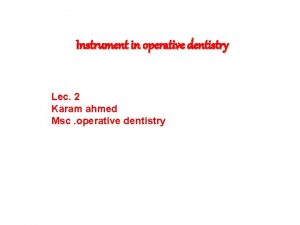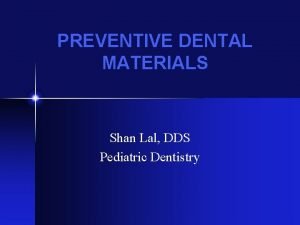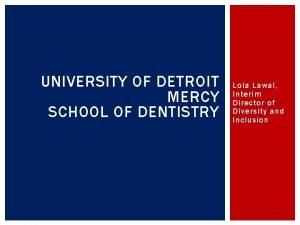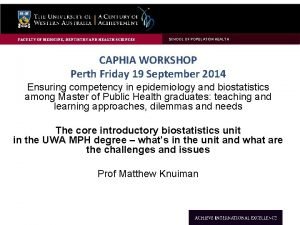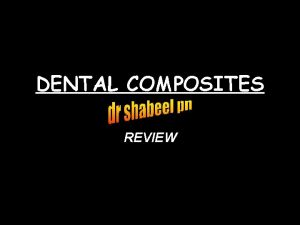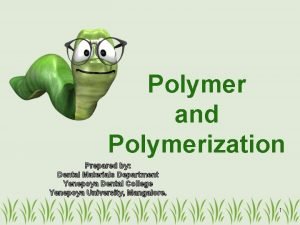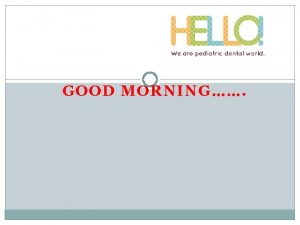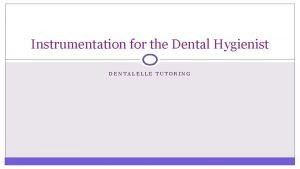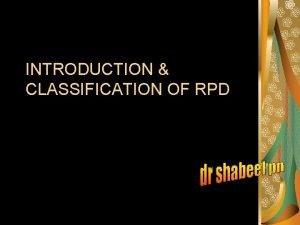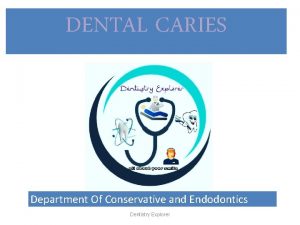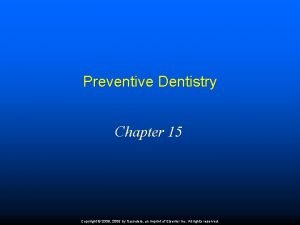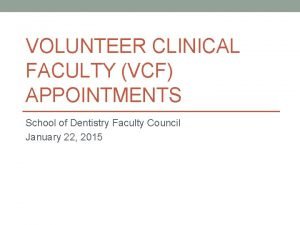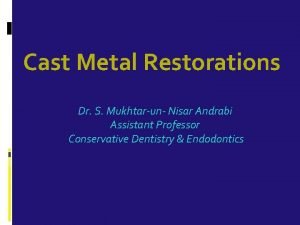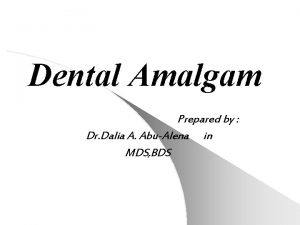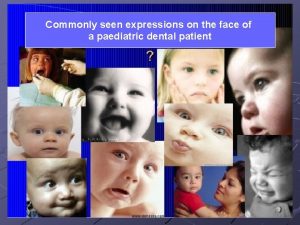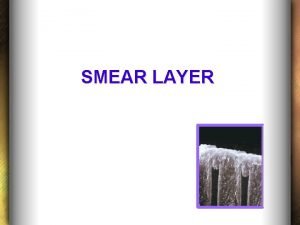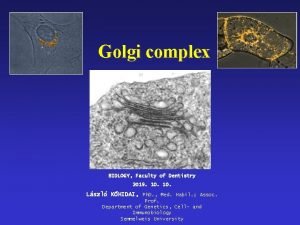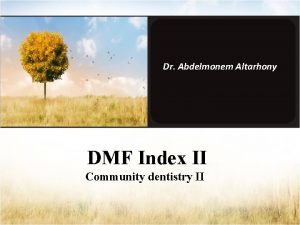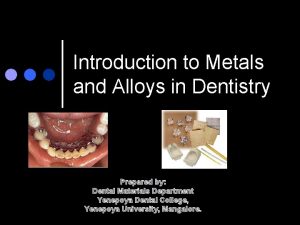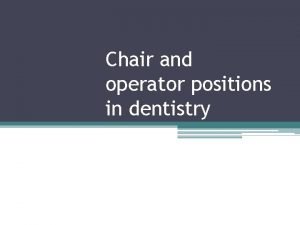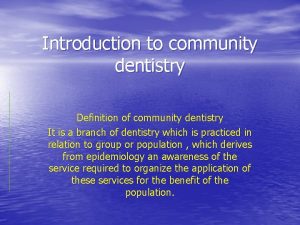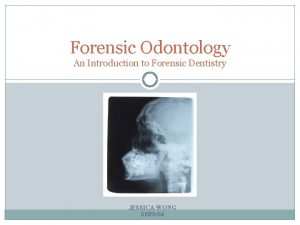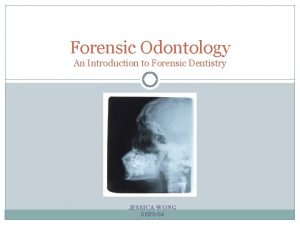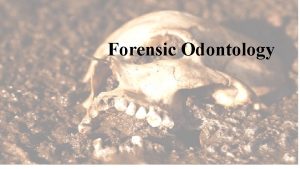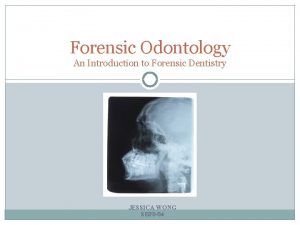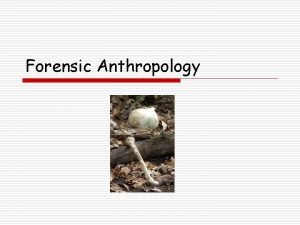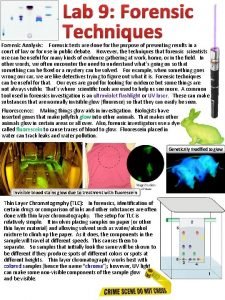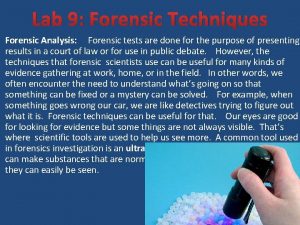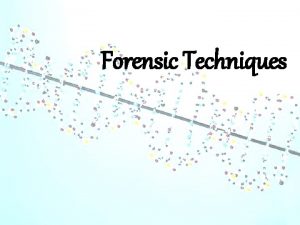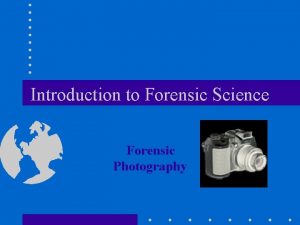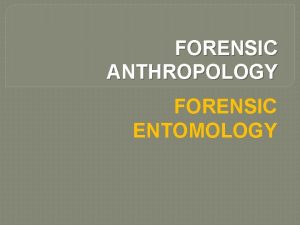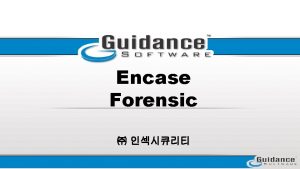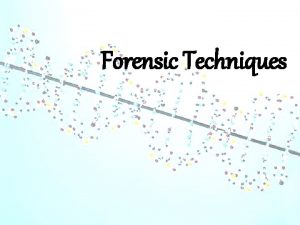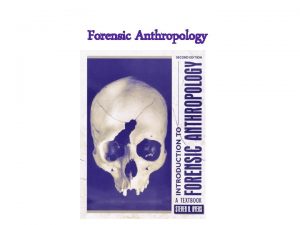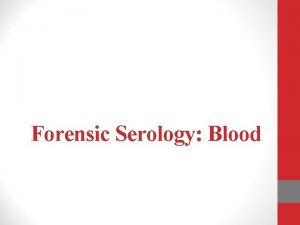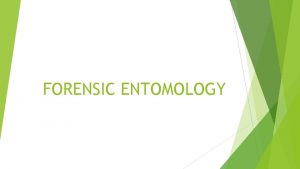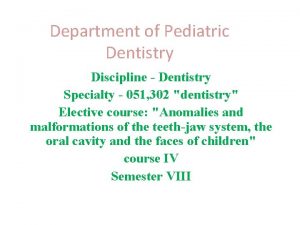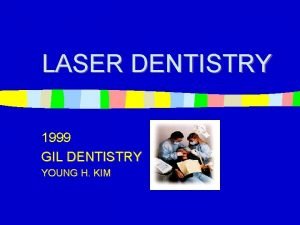FORENSIC DENTISTRY COMMUNITY DENTISTRY Forensic dentistry or forensic





























- Slides: 29

FORENSIC DENTISTRY COMMUNITY DENTISTRY

Forensic dentistry or forensic odontology: It is the proper handling, examination and evaluation of dental evidence, which will be then presented in the interest of justice.

Forensic odontology is derived from Latin, meaning a forum or where legal matters are discussed.

It is the identification discipline based upon the recognition of unique features present in each person's dental structures. It comes into use when identification by the use of skin (ex: fingerprints) is not possible.

Most forensic dentists are board certified and members of professional organizations. Forensic dentistry relies on the detailed knowledge of the teeth and jaws possessed by a dentist

This skill incorporates an education in dental anatomy, pathology, radiographs dental and materials, their interpretation, and developmental anomalies & others. Forensic identification plays a major role in manmade or natural disaster.

Dental identification of humans occurs for a number of different reasons: The bodies of victims of violent crimes, fires, and motor vehicle accidents. 1. Persons who have been deceased for some time prior to discovery, 2. Those found in water, can be disfigured to such an extent that identification through conventional methods are difficult.

In the case of forensic dentistry, experts (forensic dentists) can use dental records for: I. Identification of found human remains. II. Identification the suspect through the assessment of bite mark injuries in cases of abuse in (child) and in women during sexual attacks.

Identification of found human remains: It is done by using dental records. The principle of dental identification is that postmortem dental remains can be compared with antemortem dental records, including: > written notes, > study casts, > radiographs, > photographs etc, to confirm identity.

Explainable discrepancies It is normally relate to the time elapsed between the antemortem & postmortem records. Ex: it includes the teeth extracted or restorations placed were found in postmortem records

Unexplainable discrepancy: Ex: a tooth is not present on the antemortem record but is present on the postmortem record then exclusion must be made. If there are no antemortem dental records, a postmortem dental profile will provide information on the victim's: 1) Age: 2) Race. 3) Gender. 4) Socio-economic status. 5) Occupation, dietary habits & dental or systemic disease.

1 -Age: In children: The patterns of tooth eruption, the root length, tooth wear were assessed. In young adults: The third molar development. In middle-aged and older adults: Periodontal disease progression, excessive wear, multiple restorations, extractions, bone pathosis and complex restorative work were assessed.

Race: It can be assessed : 2. q Skull shape and form. q cusps of Carabelli, q Shovel-shaped incisors, q Multi-cusped premolars.

2. Gender: It can be assessed from q q Skull shape and form, (no gender differences regarding teeth morphology), Presence or absence of Y-chromatin in teeth, q DNA analysis, q Mandibular canine's size.

2. Socio-economic status: It can be assessed from quality, quantity and presence or absence of dental treatment. .

2. Occupation, dietary habits and dental or systemic diseases. ■ The presence of erosion can suggest alcohol or an eating disorder while stains can indicate smoking, tetracycline. ■ Unusual wear patterns may result from pipe stems, cigarette holders.

II. Identification the suspect through the assessment of bite mark injuries in cases of abuse in ((child, spousal, elder) and in women during sexual attacks. Bite marks can be found on: The victim (by the attacker), The attacker (suspect) when a victim attempts to defend himself, An object found at the crime scene

Typical presentation of bite- mark injuries: Human bite-marks may be found on almost all parts of the human body skin. In defensive circumstances, the arms and hands are often bitten. The injuries caused by teeth can range from bruises to scrapes and cuts or lacerations.

It is possible to identify specific types of teeth by their class characteristics: □Ex: incisors produce rectangular injuries and canines produce triangular injuries. □Other characteristics include fractures, rotations, attritional wear, congenital malformations, etc. □When these are recorded in the injury it may be possible to compare them to identify the specific teeth (person) that caused the injury.

Evidence collection from the bite victim □Dentists should be familiar with the general principles of evidence collection. Documentation: □Make a descriptive record of the injury, including the physical appearance, color, size and orientation of the injury, location on the body, relative contour and elasticity of the site, and types of injuries 1.

2. Photographs: □Take photographs, either color or black-and-white films. □A reference scale (ruler) should be placed in the same plane as the injury and visible in the photographs to enable subsequent measurements. 3. Impression: □Fabricate an impression of the bitten surface to record any irregularities produced by the teeth.

. Saliva swab: 4 1. Saliva will have been deposited on the skin during biting and this should be collected analyzed. 2. A buccal swab or a sample of whole blood must be collected from the victim at this time to assess the victim's DNA.

Evidence collection from the bite suspect: The following evidences are recovered during examination of the bite-mark suspect: 1 -Clinical examination : The extra & intra-oral structures are examined & noted on a dental chart. Special attention is focused on the status of the dental health, occlusion & mandibular articulation, tooth mobility, periodontal pocketing, dental restorations, diastemata, fractures, caries, etc. , & the function of masticatory muscles.

2. Photographs: Full facial & profile photographs are produced in addition to frontal & lateral views of the teeth in occlusion. 3. Impressions: It is necessary to produce extremely accurate study casts of the teeth that record all characteristics of the dentition. 4. Bite sample A sample of the suspect's bite is recorded in centric occlusion using a wax. 5. Salivary sample: it is also taken for DNA testing.

Forensic physical and biological techniques for comparison: 1. The suspect's study casts with the actual or photographs of the bite mark, The suspect's teeth pattern of dental cast using tracing with photographs of the bitemark 2. The suspect's test bites with the actual bitemark. The conclusions are often based on the expert's level of personal experience.

Factors that may affect the accuracy of bite mark identification include: 1) Time-dependent changes of the bite mark on living bodies, 2) Effects of where the bite mark was found, 3) 4) 5) Damage on soft tissue, Similarities in dentition among individuals, Poor in techniques, ex: photography & impressions.

The dental profiles of the suspect are subject to change any time. For example: 1. Loss of teeth. 2. Teeth attack by dental caries. So, the suspect's DNA profile obtained from saliva or blood with salivary DNA surrounding the bite-mark area proves to be a more reliable form of identification. * Dentist not only improves health by doing treatment in private clinic or preventive program in a community, but also plays a major role in justice achievement.

Even if the dentist cannot match the available evidence, to someone's existing dental records, the dentist can provide important clues to identity which may help the investigators.

For example, The dentist can make estimates about age, socioeconomic class and history based on examination of the teeth. By collating this evidence with evidence from other forensic examiners investigators can narrow down the identity possibilities
 What is forensic odontology definition
What is forensic odontology definition Forensic dentistry history
Forensic dentistry history Who is this
Who is this Forensic pathologist vs forensic anthropologist
Forensic pathologist vs forensic anthropologist Askov in public health dentistry
Askov in public health dentistry Evaluate together in community mobilization
Evaluate together in community mobilization Non cutting dental instruments
Non cutting dental instruments Preventive dental materials
Preventive dental materials Detroit mercy summer enrichment program
Detroit mercy summer enrichment program Faculty of medicine dentistry and health sciences
Faculty of medicine dentistry and health sciences Composite chemistry definition
Composite chemistry definition Blowfly life cycle
Blowfly life cycle Polymeric dental materials
Polymeric dental materials Elyzol
Elyzol Dr br vacher
Dr br vacher Modified pen grasp in dentistry
Modified pen grasp in dentistry Applegate rules for rpd
Applegate rules for rpd Millers liquefaction foci
Millers liquefaction foci Chapter 15 preventive dentistry
Chapter 15 preventive dentistry Vcf dentistry
Vcf dentistry Skirts in cast gold restoration
Skirts in cast gold restoration Lathe cut alloy
Lathe cut alloy Tense cooperative behavior
Tense cooperative behavior Restorative instruments in dentistry
Restorative instruments in dentistry Bin angled chisel
Bin angled chisel Smear layer definizione
Smear layer definizione Dentistry 2019
Dentistry 2019 Difoti caries detection
Difoti caries detection Types of sprue in dentistry
Types of sprue in dentistry Chair position for cavity preparation
Chair position for cavity preparation






